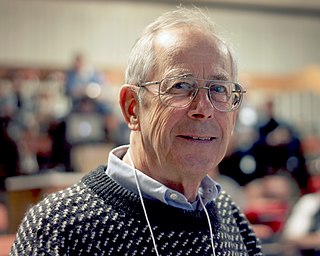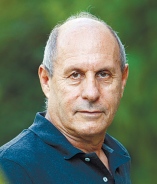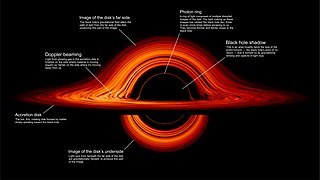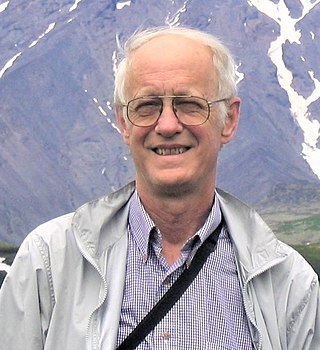Related Research Articles
Christopher Fulton McKee is an astrophysicist.
The Sunyaev–Zeldovich effect is the spectral distortion of the cosmic microwave background (CMB) through inverse Compton scattering by high-energy electrons in galaxy clusters, in which the low-energy CMB photons receive an average energy boost during collision with the high-energy cluster electrons. Observed distortions of the cosmic microwave background spectrum are used to detect the disturbance of density in the universe. Using the Sunyaev–Zeldovich effect, dense clusters of galaxies have been observed.

Phillip James Edwin Peebles is a Canadian-American astrophysicist, astronomer, and theoretical cosmologist who is currently the Albert Einstein Professor in Science, emeritus, at Princeton University. He is widely regarded as one of the world's leading theoretical cosmologists in the period since 1970, with major theoretical contributions to primordial nucleosynthesis, dark matter, the cosmic microwave background, and structure formation.

Adam Guy Riess is an American astrophysicist and Bloomberg Distinguished Professor at Johns Hopkins University and the Space Telescope Science Institute. He is known for his research in using supernovae as cosmological probes. Riess shared both the 2006 Shaw Prize in Astronomy and the 2011 Nobel Prize in Physics with Saul Perlmutter and Brian P. Schmidt for providing evidence that the expansion of the universe is accelerating.

The Bullet Cluster consists of two colliding clusters of galaxies. Strictly speaking, the name Bullet Cluster refers to the smaller subcluster, moving away from the larger one. It is at a comoving radial distance of 1.141 Gpc.
Peter Westervelt was an American physicist, noted for his work in nonlinear acoustics, and Professor Emeritus of Physics at Brown University.

Adolfo Figueroa Viñas is the first Puerto Rican astrophysicist at the National Aeronautics and Space Administration (NASA) and is an expert in solar and space plasma physics at the Heliophysics Science Division. As a staff scientist his research interests include studying plasma kinetic physics and magnetohydrodynamics of the solar wind, heliosphere, shock waves, MHD and kinetic simulation of plasma instabilities, and turbulent processes associated with space, solar and astrophysical plasmas.

The firehose instability is a dynamical instability of thin or elongated galaxies. The instability causes the galaxy to buckle or bend in a direction perpendicular to its long axis. After the instability has run its course, the galaxy is less elongated than before. Any sufficiently thin stellar system, in which some component of the internal velocity is in the form of random or counter-streaming motions, is subject to the instability.

Padma Kant Shukla was a distinguished Professor and first International Chair of the Physics and Astronomy Department of Ruhr-University Bochum in Germany. He was also the director of the International Centre for Advanced Studies in Physical Sciences at Ruhr-University Bochum. He held a PhD in physics from Banaras Hindu University in Varanasi, India and a second doctorate in Theoretical Plasma Physics from Umeå University in Sweden.

Tsvi Piran is an Israeli theoretical physicist and astrophysicist, best known for his work on Gamma-ray Bursts (GRBs) and on numerical relativity. The recipient of the 2019 EMET prize award in Physics and Space Research.
Ilene Busch-Vishniac is an American-born mechanical engineer and university administrator. She served as Dean of the Whiting School of Engineering at Johns Hopkins University from 1998 to 2003 then resigned the position to serve as President of the Acoustical Society of America (ASA), an elected non-gratis position, from 2003 to 2005. She served as Provost and Vice-President for Academic Affairs at McMaster University from 2007 to 2012, and as President of the University of Saskatchewan from 2012 to 2014. In 2018 she joined startup Sonavi Labs as Chief Innovation Officer. She has written research papers for the ASME on matters related to tribology.
Marc Kamionkowski is an American theoretical physicist and currently the William R. Kenan, Jr. Professor of Physics and Astronomy at Johns Hopkins University. His research interests include particle physics, dark matter, inflation, the cosmic microwave background and gravitational waves.

An accretion disk is a structure formed by diffuse material in orbital motion around a massive central body. The central body is most frequently a star. Friction, uneven irradiance, magnetohydrodynamic effects, and other forces induce instabilities causing orbiting material in the disk to spiral inward toward the central body. Gravitational and frictional forces compress and raise the temperature of the material, causing the emission of electromagnetic radiation. The frequency range of that radiation depends on the central object's mass. Accretion disks of young stars and protostars radiate in the infrared; those around neutron stars and black holes in the X-ray part of the spectrum. The study of oscillation modes in accretion disks is referred to as diskoseismology.
Miklos Porkolab (born March 24, 1939) is a Hungarian-American physicist specializing in plasma physics.
Ethan R. Siegel is an American theoretical astrophysicist and science writer, who studies the Big Bang theory. In the past he has been a professor at Lewis & Clark College and a blogger at Starts With a Bang, on ScienceBlogs and also on Forbes.com since 2016.
Stuart Louis Shapiro is an American theoretical astrophysicist, who works on numerical relativity with applications in astrophysics, specialising in compact objects such as neutron stars and black holes.
Patrick Henry Diamond is an American theoretical plasma physicist. He is currently a professor at the University of California, San Diego, and a director of the Fusion Theory Institute at the National Fusion Research Institute in Daejeon, South Korea, where the KSTAR Tokamak is operated.

Richard Van Evera Lovelace is an American astrophysicist and plasma physicist. He is best known for the discovery of the period of the pulsar in the Crab Nebula, which helped to prove that pulsars are rotating neutron stars, for developing a magnetic model of astrophysical jets from galaxies, and for developing a model of Rossby waves in accretion disks. He organized a US-Russia collaboration in plasma astrophysics, which focused on modeling of plasma accretion and outflows from magnetized rotating stars.
Alexandre Lazarian is an astrophysicist. He is a professor of astronomy at the University of Wisconsin–Madison with a joint appointment at the Department of Physics. He is a fellow of the American Physical Society.
Carolyn C. Kuranz is an American plasma physicist whose research involves the use of high-powered lasers at the National Ignition Facility both to help develop inertial confinement fusion and to study how matter behaves in conditions similar to those in shock waves in astrophysics. She is an associate professor at the University of Michigan, in the Department of Nuclear Engineering and Radiological Sciences.
References
- ↑ "Curriculum Vitae" (PDF).
- ↑ Vishniac, Ethan Tecumseh (1980). Topics in the evolution of cosmological perturbations (Ph.D. thesis). Harvard University. OCLC 8719739 – via ProQuest.
- ↑ "APS fellow archive". APS. Retrieved 21 September 2020.